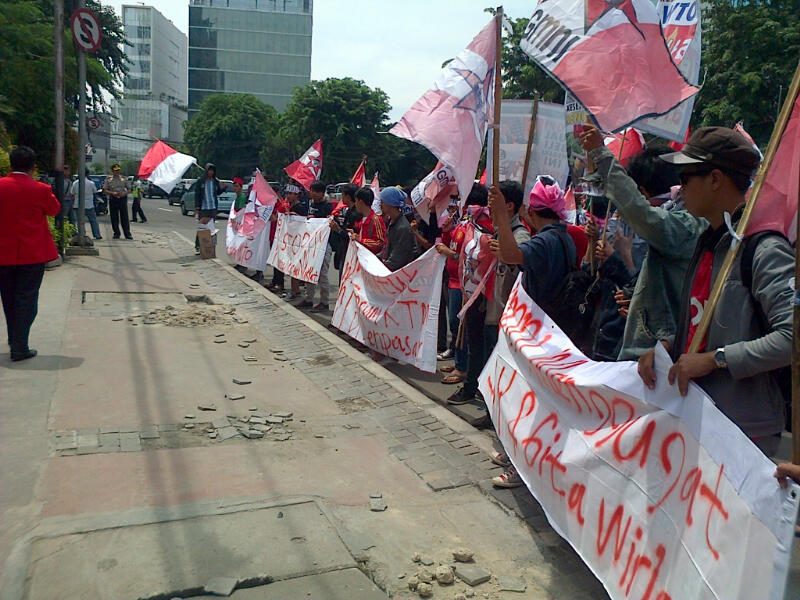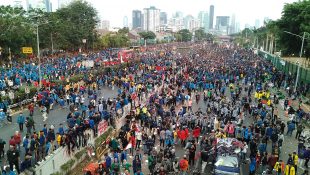In a recent article Edward Aspinall suggests that the current student mobilisation revives old patterns from the Indonesian student movement. But there are three new manifestations in the current movement that can hardly be understood in terms of the old patterns.
First, in mobilisation, the students have rarely declared their position as a distinct sector of the popular movement. Unlike in the past, these students comfortably put themselves within a broader alliance of the popular movement alongside the worker, the rural poor, and the environmental movement. Unsurprisingly, much of the mobilisation occurs under the banner of “people’s alliance” (aliansi rakyat).
Second, due to this specific form of mobilisation, today’s student movement no longer reproduces the notion of a “moral movement” which the student movement in the New Order era strongly signalled (see https://uimerakyat.wordpress.com/2011/10/08/panggung-mitologi-dalam-hegemoni-negara-%E2%80%93-gerakan-mahasiswa-di-bawah-orde-baru/). In current protests, they no longer present as a societal force that stands above the existing societal configuration. This position has a necessary consequence in the character of the movement itself. The student consciously views their movement as a political movement; they target the existing dominant power within the state (i.e. the oligarchs) as the culprit behind their unfortunate fate.
Third, we also need to recognize the emergence of a new actor in the recent student protests: the high school student, particularly from vocational middle schools (https://jakbarnews.pikiran-rakyat.com/nasional/pr-37815019/kisah-angga-anak-stm-ikut-demo-tolak-omnibus-law-uu-cipta-kerja-ada-undangan). The involvement suggests a novel trend in the current student protests, whereby as the students’ aspiration have attracted other segment of the Indonesian youth. This rarely happened in past experience student movements.
We can propose a specific hypothesis to understand the novelty of the current movement, starting from the premise that this new development is associated with particular social changes in post-authoritarian Indonesian society. This change is happening at three levels: economics, ideology, and politics.
At the economic level, the neoliberal transformation of Indonesia’s economic structure introduced after the fall of Suharto’s regime impacted the relationship between the student movement and other sectors. The neoliberal restructure, through the introduction of labour market flexibility, eliminates the privileged position of the Indonesian student in the existing job market. Holding a degree does not guarantee a job. Even after getting a job, there is no guarantee that student will get secure and decent employment, as contractual and outsourced work becomes the norm. Hence, in the long-run, the socio-economic position of the student is no longer different from the ordinary worker without higher education.
At the ideological level, the politicisation of the current form of student movement might be associated with the popularity of leftist literature, especially in online forums, among students and young people. Although Indonesia’s democracy has not eliminated the phobia of communism, the massive use of social media generates space for leftist thinking to shape the ideology of the student movement. This “online-leftism” provides a more political framework for the aspiration of student movement and sees the importance of addressing the problem in more systemic rather than moralistic. The popularity of the term “oligarchy” to describe the fundamental relation of power that needs to be confronted by the students strongly indicates this view.
At the political level, the patronage relationship between the elite and the student movement is no longer as intense as it was. The elite no longer sees the student movement as a force that need to be accommodated in their political calculations. I argue that this alteration is the result of democratisation itself, where political competition at the elite level compels the elite to accommodate other forces in society. This competitive condition in democracy means the position of students is no longer a priority for the elite. With the erosion of elite influence in the student movement, it then becomes possible for the movement to have a clear oppositional stance towards the existing elite. This is why the student now can have an explicit political articulation.
Indonesian protests point to old patterns
The return of student protests and the government’s response have are reminiscent of the era of authoritarian rule
Like any hypothesis, further research is needed to verify its validity. The specific mechanism that occurs at these three levels needs to be identified empirically. This may be an interesting research avenue for future scholars to understand new development in Indonesia’s student movement.
Nevertheless, this new development should be treated cautiously. Personally, I believe that the changing nature of the student movement, in which students have started to see themselves as part of the broader popular movement, is good news for the student movement itself. But this is still not really how the student movement will realise their political demands. Without an exact political resolution, there is still a chance for the movement to be co-opted by other societal forces. The most potent force for co-opting the aspiration of the student movement comes from the conservative Islamic group. Not to mention the response from the state, in which the excessive use of force has become the dominant way of suppressing the movement itself. Multiple trajectories might result from this new development. We will have to wait to see what direction new form of Indonesia’s student movement will take.
 Facebook
Facebook  Twitter
Twitter  Soundcloud
Soundcloud  Youtube
Youtube  Rss
Rss 



